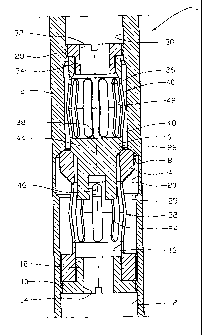Some of the information on this Web page has been provided by external sources. The Government of Canada is not responsible for the accuracy, reliability or currency of the information supplied by external sources. Users wishing to rely upon this information should consult directly with the source of the information. Content provided by external sources is not subject to official languages, privacy and accessibility requirements.
Any discrepancies in the text and image of the Claims and Abstract are due to differing posting times. Text of the Claims and Abstract are posted:
| (12) Patent: | (11) CA 2721468 |
|---|---|
| (54) English Title: | DUAL DIRECTIONAL DOWNHOLE OVERPRESSURE VALVE |
| (54) French Title: | SOUPAPE DE SURPRESSION BIDIRECTIONNELLE DE FOND DE TROU |
| Status: | Expired and beyond the Period of Reversal |
| (51) International Patent Classification (IPC): |
|
|---|---|
| (72) Inventors : |
|
| (73) Owners : |
|
| (71) Applicants : |
|
| (74) Agent: | GOWLING WLG (CANADA) LLP |
| (74) Associate agent: | |
| (45) Issued: | 2015-06-23 |
| (86) PCT Filing Date: | 2008-01-07 |
| (87) Open to Public Inspection: | 2009-07-17 |
| Examination requested: | 2012-11-21 |
| Availability of licence: | N/A |
| Dedicated to the Public: | N/A |
| (25) Language of filing: | English |
| Patent Cooperation Treaty (PCT): | Yes |
|---|---|
| (86) PCT Filing Number: | PCT/NO2008/000002 |
| (87) International Publication Number: | WO 2008085057 |
| (85) National Entry: | 2010-05-07 |
| (30) Application Priority Data: | ||||||
|---|---|---|---|---|---|---|
|
Dual directional downhole overpressure
valve (1) comprising a valve housing (2) and where a
first valve body (4) is forced with a first force against a
first valve seat (8), and where a second valve body (6)
is forced against a second valve seat (26) positioned in
the first valve body (4) with a force smaller than the
first force, the first force and the second force acting in
opposite directions.
L'invention concerne une soupape de surpression bidirectionnelle de fond de trou (1) qui comprend un boîtier de soupape (2), et dans laquelle un premier corps de soupape (4) est forcé avec une première force contre un premier siège de soupape (8) et un second corps de soupape (6) est forcé contre un second siège de soupape (26) positionné dans le premier corps de soupape (4) avec une force inférieure à la première force, la première force et la seconde force agissant dans des directions opposées.
Note: Claims are shown in the official language in which they were submitted.
Note: Descriptions are shown in the official language in which they were submitted.

2024-08-01:As part of the Next Generation Patents (NGP) transition, the Canadian Patents Database (CPD) now contains a more detailed Event History, which replicates the Event Log of our new back-office solution.
Please note that "Inactive:" events refers to events no longer in use in our new back-office solution.
For a clearer understanding of the status of the application/patent presented on this page, the site Disclaimer , as well as the definitions for Patent , Event History , Maintenance Fee and Payment History should be consulted.
| Description | Date |
|---|---|
| Time Limit for Reversal Expired | 2023-07-07 |
| Letter Sent | 2023-01-09 |
| Letter Sent | 2022-07-07 |
| Letter Sent | 2022-01-07 |
| Common Representative Appointed | 2019-10-30 |
| Common Representative Appointed | 2019-10-30 |
| Change of Address or Method of Correspondence Request Received | 2018-06-11 |
| Grant by Issuance | 2015-06-23 |
| Inactive: Cover page published | 2015-06-22 |
| Pre-grant | 2015-04-08 |
| Inactive: Final fee received | 2015-04-08 |
| Notice of Allowance is Issued | 2015-02-10 |
| Letter Sent | 2015-02-10 |
| Notice of Allowance is Issued | 2015-02-10 |
| Inactive: QS passed | 2014-10-31 |
| Inactive: Approved for allowance (AFA) | 2014-10-31 |
| Amendment Received - Voluntary Amendment | 2014-08-15 |
| Inactive: S.30(2) Rules - Examiner requisition | 2014-02-26 |
| Inactive: Report - No QC | 2014-02-24 |
| Inactive: First IPC assigned | 2013-09-26 |
| Inactive: IPC assigned | 2013-09-26 |
| Letter Sent | 2012-11-30 |
| Request for Examination Requirements Determined Compliant | 2012-11-21 |
| All Requirements for Examination Determined Compliant | 2012-11-21 |
| Request for Examination Received | 2012-11-21 |
| Letter Sent | 2012-03-08 |
| Letter Sent | 2011-02-22 |
| Letter Sent | 2011-02-22 |
| Inactive: Single transfer | 2011-02-03 |
| Inactive: Cover page published | 2010-12-14 |
| Inactive: Notice - National entry - No RFE | 2010-12-10 |
| Inactive: First IPC assigned | 2010-12-07 |
| Inactive: IPC assigned | 2010-12-07 |
| Inactive: IPC assigned | 2010-12-07 |
| Application Received - PCT | 2010-12-07 |
| Correct Applicant Request Received | 2010-07-16 |
| Inactive: Declaration of entitlement - PCT | 2010-06-02 |
| National Entry Requirements Determined Compliant | 2010-05-07 |
| Application Published (Open to Public Inspection) | 2009-07-17 |
There is no abandonment history.
The last payment was received on 2014-12-30
Note : If the full payment has not been received on or before the date indicated, a further fee may be required which may be one of the following
Please refer to the CIPO Patent Fees web page to see all current fee amounts.
Note: Records showing the ownership history in alphabetical order.
| Current Owners on Record |
|---|
| WELLTEC A/S |
| Past Owners on Record |
|---|
| OLAV EVERTSEN |
| STEFFEN EVERTSEN |